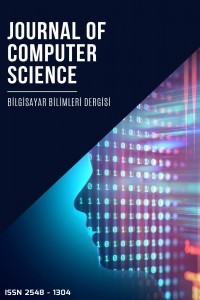Beyin Tümörü Bölütleme ve Algılamada Yeni Çekişmeli Üretken Ağ Kullanılması
Tıbbi görüntülerden beyin tümörünün algılanması araştırmacılar için aktif araştırma alanıdır. Tümör dokusunun çeşitliliği ve tümörün karmaşıklığı süreci zorlu hale getirmektedir. Bu çalışmada üç ayrı beyin tümörü veri kümesi oluşturulmuştur. Oluşturulan veri kümeleri iki boyutludur. Birinci veri kümesi 3 boyutlu görüntülerden 2 boyutlu görüntülere hiçbir değişiklik yapmadan dönüştürülen beyin tümörü veri kümesidir. İkinci veri kümesi birnci veri kümesindeki beyin harici kısımların yok edilmesiyle elde edilmiştir. Üçüncü veri kümesi ise beyin tümörünü daha iyi algılayabilmek için ikinci veri kümesi üzerinde görüntüyü keskinleştirip Gauss Filtresi ekleyerek elde edilmektedir. Buradaki amaç veri kümelerinin eğitim ve test sonuçlarına etkisini gözlemleyebilmektir. Bu çalışmada, beyin tömörü bölütlenirken ve algılanırken yeni Çekişmeli Üretken Ağ önerilmiştir. Önerilen yöntem beyin tümörünü manuel olarak değil otomatik bir şekilde yapabildiği için avantajlıdır. Önerilen yöntem SSimDCL (Supervised Similarity Dual Contrastive Learning) olarak adlandırılmıştır. Önerilen yöntem günümüzde derin öğrenme mimarileri arasında en iyi sonucu veren nnU-Net ile kıyaslanmaktadır. Kıyaslama yapılırken LPIPS ve PSNR yöntemleri tercih edilmiştir. Yapılan deneysel çalışmalar sonucunda önerilen yöntemin veri kümesi iyileştikçe daha iyi sonuçlar verdiği gözlemlenmiştir. nnU-Net yöntemi metriksel olarak daha iyi olmasına rağmen görsel sonuçlar duyusal olarak kıyaslandığında önerilen yöntemin daha iyi olduğu görülmüştür.
Using a New Generative Adversarial Network in Brain Tumor Segmentation and Detection
Brain tumor detection from medical images is an active area of research for researchers. The diversity of tumor tissue and the complexity of the tumor makes the process challenging. In this study, three separate brain tumor datasets were created. The generated datasets are two-dimensional. The first dataset is the brain tumor dataset, which is converted from 3D images to 2D images without any changes. The second dataset was obtained by eliminating the non-brain parts in the first dataset. The third dataset is obtained by sharpening the image on the second dataset and adding a Gaussian Filter to better detect the brain tumor. The aim here is to observe the effect of datasets on training and test results. In this study, the new Generative Adversarial Network is proposed when segmenting and detecting brain tumors. The proposed method is advantageous as it can make the brain tumor automatically, not manually. The proposed method is named SSimDCL (Supervised Similarity Dual Contrastive Learning). The proposed method is compared with nnU-Net, which gives the best results among deep learning architectures today. While comparing, LPIPS and PSNR methods were preferred. As a result of the experimental studies, it has been observed that the proposed method gives better results as the dataset improves. Although the nnU-Net method is better metrically, it was seen that the proposed method was better when the visual results were compared sensorially.
___
- BRATS. (erişim: 20.05.2022). Bmultimodal brain tumor segmentation challenge 2019. 2019. http://bra intumorsegmentation.org/
- Chen, P. F., Steen, R. G., Yezzi, A., & Krim, H. (2009, April). Brain MRI T 1-Map and T 1-weighted image segmentation in a variational framework. In 2009 IEEE International Conference on Acoustics, Speech and Signal Processing (pp. 417-420). IEEE.
